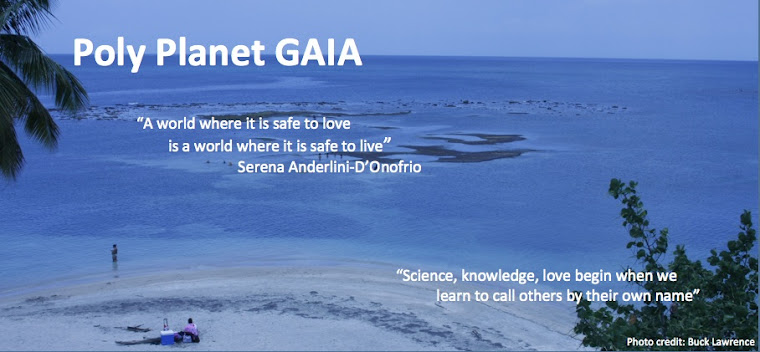Dear Earthlings:
The
EcoSex course at U Conn is in process. It's a great experience. We
are reading amazing books. Thinking out of the box and across
disciplines. Students are sending their responses in, with discussion
questions. In class, we connect the dots: a
holograph of what we've read together, the "required readings."
Multiple perspectives and good synergy. Here, we offer a glimpse.
Lynn Margulis and Dorion Sagan's Mystery Dance was one of two theory-of-science books. We got four responses: from John, Alissa, Rhiann, Adam, and Michael.
Here's Rhiann's take:
Response to Lynn Margulis and Dorion Sagan's Mystery Dance: On the Evolution of Human Sexuality
I
was surprised by much of Mystery Dance. One section that stood out to me was
titled, “Opposite or “Neighbor” Sexes?” The authors highlight historian, Thomas
Laqueur’s, analyzation of the one-sex model from the Renaissance period. It
surprised me that men and women were considered neighbors then as opposed to
opposites. To me, these definitions should be the other way around. It seems to
me that considering men and women neighbors is more forward thinking then
considering them opposites. As I write this, I wonder if any of my peers feel
the same? Does anyone believe that the thinkers of the Renaissance knew more
about intercourse then we do? I would say that in some cases this is definitely
true. I also feel that viewing our bodies as neighbors instead of opposites
would make for more liberating sex.
However, the woman was still the
inferior partner in both definitions. Why is that? How is it that cultural
constructs of femininity and sexuality span centuries? Perhaps, this phenomenon
comes from biology. Anatomically, the vagina is the receiver during
intercourse. Maybe this is where these ideas of inferiority come from. It is
very interesting to me that this concept is the same in both definitions of
neighbors and opposites.
Additionally, I wanted to comment on
the language. It’s noted that in several languages during the Renaissance the
uterus and scrotum were labeled with the same word. These words expressed a
shared type of human body. Currently, there are more specific labels for the
genitals of both males and females. However, can that only be chalked up to
science and medicine? Why do we have to distinguish? Could we distinguish
medically and not sexually? I cannot decide if the double label from the
Renaissance is under developed or ahead of its time. Overall, I was very
surprised by the concepts brought up in this section and the parallels that can
be drawn between the Renaissance and modern culture.
Rhiann Peterson
Published with permission
WGSS 3998 - Ecosexuality and the Ecology of Love
Prof. Serena Anderlini-D'Onofrio
U Conn, Storrs, Spring 2013
Dear Earthlings:
Let "nature" be your teacher in the arts of love. Education is the heart of democracy, education to love. Come
back for more wonders: Students Responses to appear every Tuesday.
Book Reports to be scheduled soon, every other Thursday. Check out our summer offerings: Ecosexuality in Portland, OR, July 17-21. Info and Registration here!
Namaste,
Serena Anderlini-D'Onofrio, PhD
Gilf Gaia Extraordinaire
University of Puerto Rico, Mayaguez
Follow us in the social media
Poly Planet GAIA Blog:
http://polyplanet.blogspot.
http://polyplanet.blogspot.
Website: www.serenagaia.com
Be Appraised of Ecosex Community Project PostaHouse
Become a Fan: www.facebook.com/GaiaBlessings
Author's Page/Lists all books:
YouTube Uploaded Videos: http://www.youtube.com/













